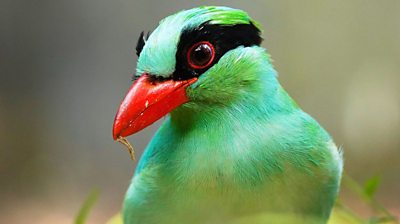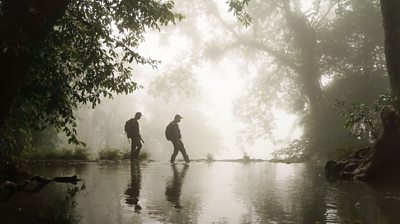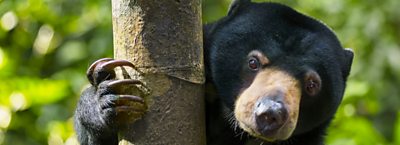Asia’s animals are under pressure like never before. All over the continent remarkable people are dedicating their lives to saving them and they are working tirelessly to bring about positive change, united by one aim: to protect the continent’s natural riches for future generations.
Northeast Borneo is home to one of Asia’s most elusive mammals - the sun bear. All too often orphaned cubs are sold as pets. Those that are rescued end up at the Bornean Sun Bear Conservation Centre, run by Siew Te Wong. He’s on a mission to release Sika, a bear who’s been in his care for several years. Only dense, remote forests are suitable for the release, and getting Sika there is a race against time, involving cars and even a helicopter. Finally, after twenty hours, the team bid an emotional farewell as Sika is freed.
In some of the continent’s forests, wildlife is being removed at an alarming rate. In Java, songbirds are poached for the pet trade and Panji Gusti Akbar is working to save the Javan green magpie. He has over sixty in a captive breeding project, possibly more than remain in the wild. He’s working to win over songbird owners like Mr Neo who owns several award-winning singing birds. Panji and Mr Neo tour a village that used to be a hotbed of poaching and is now a centre for bird tourism. Mr Neo discovers the thrill of seeing birds in the wild and decides to donate his own magpie to Panji’s sanctuary. One day Panji’s birds will be released into the wild.

In Japan scientists are giving us a glimpse into what conservation could become in the future. They take pregnant sharks, killed accidentally in fishing nets, and rescue their unborn young in an incubating system that simulates a womb. The embryos are fed by their existing yolk sacs but they need to be surrounded by a special chemical fluid, similar to that provided by their mother. After several months, the baby sharks will be released into an aquarium.
On Java Egin Salim and his team work with local fishing communities. Many rare species that are caught in drift nets by accident end up in the market. New research suggests that endangered rays may be able to see green lights, whereas other fish can’t. An experimental net festooned with green lights is trialled at sea and after an anxious wait, it is pulled in. No rays have been caught. This trial gives hope that ray species across Asia could be protected.
In Hong Kong a team are testing a new way of protecting another of Asia’s most threatened marine creatures. Yvonne Sadovy, a marine biologist, is working with IT experts to design an AI-powered app that can use facial recognition to distinguish between different Napoleon wrasse. These rare fish are highly-prized delicacies, and the app will allow officials to tell if restaurants are breaking strict quotas by selling more fish than they are permitted to.

Wildlife is one of the world’s largest black-market commodities and Nepal sits at the crossroads of this illegal trade. Kumar Paudel is working to stop smugglers. He teaches customs officials how to identify animal products and works with informers to supply intelligence to the police. As a result, traffickers are caught, including one man with a large sack of pangolin scales.
Across Asia pangolins are in serious decline. Sunda pangolins are being squeezed out of their forest habitats by urban development. Kalai Balakrishnan runs Singapore’s only 24 hour wildlife rescue charity, and he’s a busy man. In just the space of a few hours he rescues two pangolins, one from a golf course, and the other from a multi-story car park.
Kalai’s work gives urban wildlife a much-needed helping hand. But elsewhere in Asia, conservationists are attempting something even more ambitious: breaking the link between the destruction of the natural world and poverty. Hotlin Ompussungu works in deprived areas of Indonesia. She recognises that people fell trees out of desperation – they need to sell the wood to pay for healthcare for their families. Villagers are encouraged to grow trees from seeds at home and then bring the saplings to Hotlin’s clinic as payment towards their treatment. As a result, forests that were once stripped of vegetation are now green again.
- Watch all episodes of Asia on �鶹�� iPlayer and add to your Watchlist now
- Watch Asia, episode four on �鶹�� One from Sunday 8 December at 6.20pm
FS
Filming locations

- Sun bear: Sepilok and Tabin reserve, Sabah, Malaysia
- Javan green magpie: Cikananga Wildlife Centre, and Yogyakarta City, and Jatimulyo village – all on Java, Indonesia
- Artificial uterus: Okinawa, Japan
- Bycatch prevention: Muncar, West Java, Indonesia
- Napoleon fish: Hong Kong
- Wildlife trade interception: Kathmandu, Nepal
- Animal rescue: Singapore
- Conservation hospital: Sumatra and West Kalimantan, Indonesia
